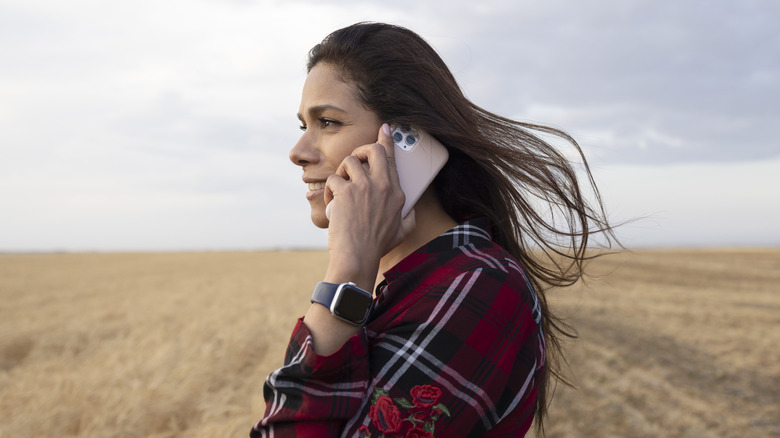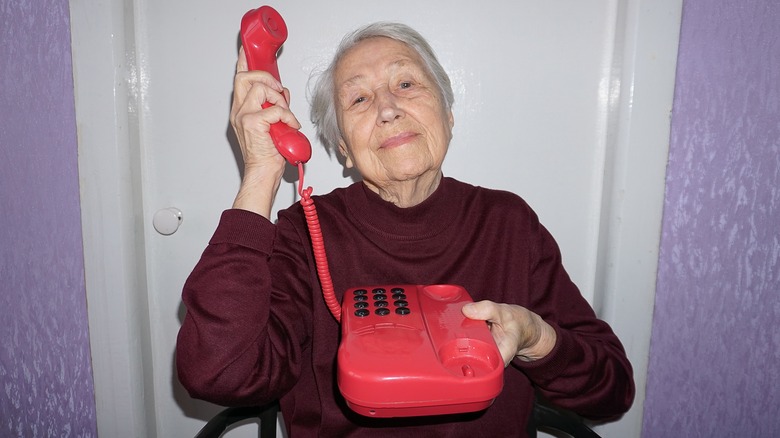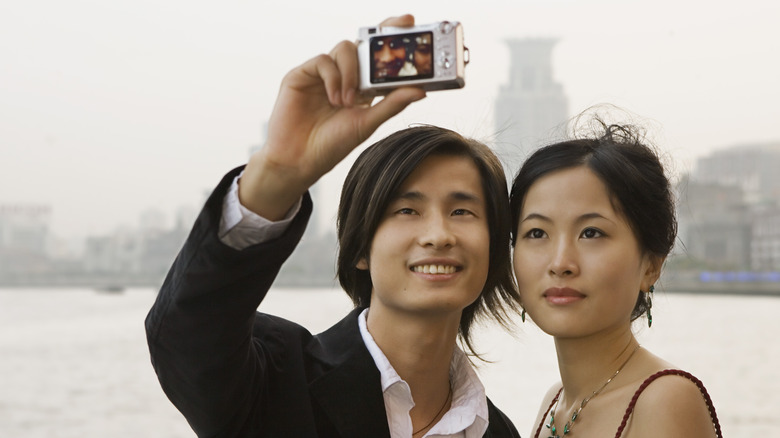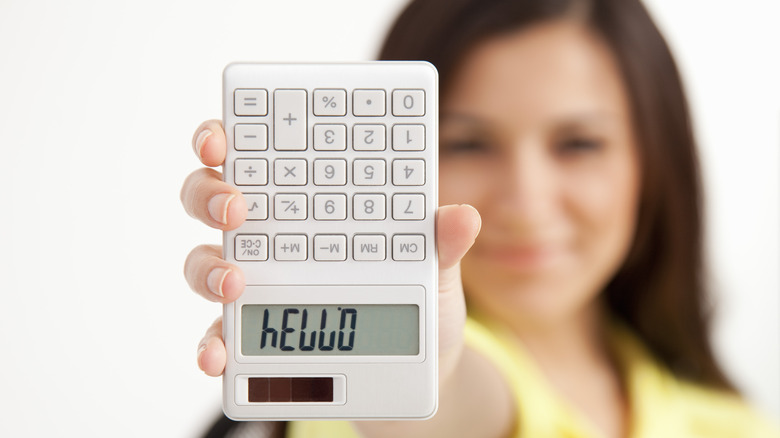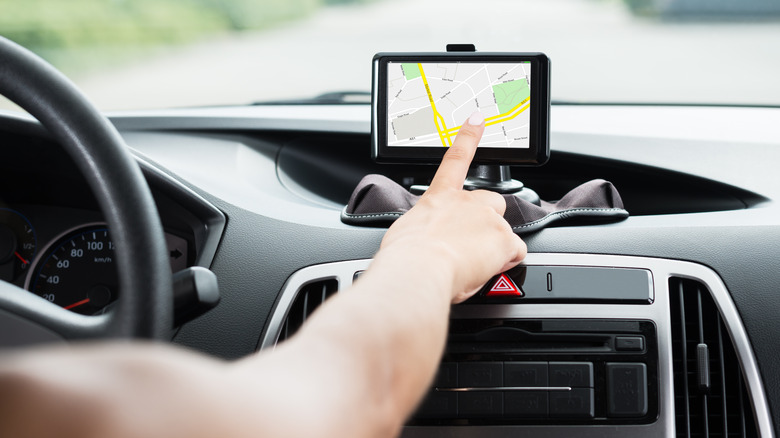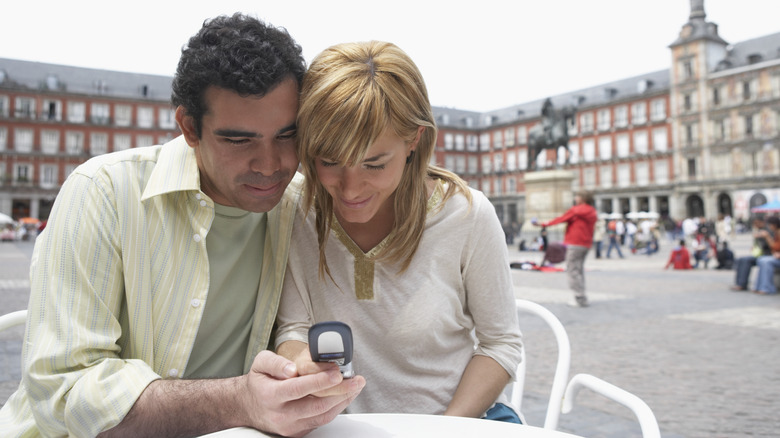11 Pieces Of Technology Made Obsolete By The Smartphone
At the dawn of the 21st century, personal computers and consumer home internet had finally reached the mainstream, and mobile phone technology was coming into its own. But few could have predicted that in just a few short years, those separate pieces of technology would be combined into a single device that would impact every facet of our lives — from how we hail a ride or board an airplane to how we manage to keep in touch or get our news — to a degree arguably greater than anything that had come before.
Of course, we're talking about your flashlight. We're talking about your checkbook. Your weather forecaster, your fitness coach, your car starter, and your thermostat. We're talking about all of those things and more, rolled up into a single pocket-sized package. We're talking about the smartphone.
The beauty and the genius of the smartphone is its adaptability. Granted, it's a complex piece of equipment, but it's also simple. It has a few key components — things like a camera, a speaker, and an accelerometer — and the limitless ability to use them together to perform any number of tasks. When everyone has a device that can do just about anything, there are going to be a lot of standalone devices that get left in the dust. Here are 11 pieces of technology you stopped needing the day you got your first smartphone.
Landline phones
Landline phones are the first and most obvious casualty of the smartphone era. Then again, it's a little wild to think that our pocket computers trace their lineage back to the humble telephone. Let's put it this way: if you were to rank all the apps on your smartphone by how often you use them, would the Phone app make the top ten? One in four smartphone users never uses their mobile device to make voice calls at all (via The Guardian).
The landline phone had but one function, and even so, it was light on features. Your phone number? You shared it with everyone else who lived in your house. Calling another area code? That cost extra. And unless you had a cordless phone, it was like using a smartphone with the battery removed — you were on a 10-foot leash connected to an outlet in your kitchen.
While they didn't support apps — an "app" wasn't even a word in the landline's heyday — they did support an ecosystem of peripheral devices such as answering machines and caller ID boxes. If you left your house, you couldn't bring your phone with you; instead, you brought quarters in case you needed to use a payphone. With the advent of the smartphone, millions of landline phones and associated devices were permanently disconnected, their dial tones silenced forever.
Point-and-shoot digital cameras
Between 2008 and 2021, sales of point-and-shoot cameras fell by more than 97%. Those numbers don't just signify a steep decline in sales; they tell the story of plummeting over the edge of a sheer vertical cliff with an approximate height of 107 million cameras. It just so happens that this timeline aligns with the growing ubiquity of smartphones. And in this instance, it really is a matter of causation rather than coincidence.
It was really the transition from film to digital that marked the beginning of the end for point-and-shoot cameras. With this transition, consumers became familiar with the concept of the megapixel (MP). This is a rabbit hole that goes down as deep as you're willing to follow it, but at a high level, the resolution of the human eye is somewhere around 5 to 15 MP. Keep that in mind for a moment.
Smartphones have had cameras on them from the beginning, and since then they've only gotten better. When the iPhone 6S and iPhone 6S Plus were released in 2015, they included 12 MP cameras as standard items. That's comfortably at the higher end of the range of what people can even see, and it seems consumers generally believe that to be enough MP for everyday use. The camera resolution on the current base iPhone 14 remains 12 MP to this day. Meanwhile, the folks at Samsung took a slightly different approach. The camera on the Galaxy S20 Ultra has a resolution of 108 MP. The point-and-shoot camera is as popular as ever — just not as a standalone item.
Calculators
In its prime, the electronic pocket calculator was kind of a big deal. It's easily in the (completely fictitious) hall of fame of mathematical aids, rubbing shoulders with the likes of the slide rule, the abacus, and fingers and toes. Calculators made it easy to perform mathematical calculations quickly and accurately. This combination of usefulness and simplicity made them a perfect target for smartphones.
Even at the height of their popularity, few pockets ever held a pocket calculator with any regularity. Let's go back to 2004 for a hot minute: Facebook was still called "The Facebook," Gmail was available by invite only, and "From Justin to Kelly" and "Gigli" were the major contenders at the Razzies with 9 nominations each. Now, you've just had dinner at Chi-Chi's with a group of friends and it's time to divvy up the bill. Does anyone have a calculator on them? No. Not then, not ever.
Not until the smartphone, that is. So even if you have a calculator in a drawer somewhere, why dig it out when there truly is a pocket calculator in every pocket in the form of a smartphone? It's enough to make you question the relevance of even advanced graphing calculators; or, if not their relevance, at least their price tag when a free app can provide the same functionality.
Alarm clocks
There's a segment of the population who sees themselves as "morning people." Truly, they exist. But for everyone else, there's the alarm clock, the most fundamental and reliable wake-up device since the sun. Remember, if you will, they were clocks that sat on your bedside table, often digital, but sometimes honest-to-goodness analog clocks that ticked and needed daily winding once upon a time. And when the designated time in the morning arrived, they'd unloose a cacophony so frightening you were forced to throw the thing across the room when you couldn't find the snooze button. Or perhaps your results varied.
When the smartphone first arrived on the scene, it already had all of the qualifications of a functioning alarm clock, those being the ability to keep time (and more accurately at that) and the capacity to make sounds. Add that smartphones could be easily customized to play a variety of sounds at a volume of your choosing, and it's not surprising that the alarm clock industry has taken a hit, although it still survives as a niche market. No more losing sleep in a hotel room because you're worried the alarm clock won't work — you already brought your own, and you didn't even have to think about it.
Walkie talkies
Walkie talkies were more than just a convenient mobile phone workaround for the writers of "Stranger Things." They're used to this day in a variety of workplaces, from manufacturing floors to big box stores. For some circumstances, they can be a quick and effective tool for getting a message to a lot of people simultaneously, while also being more targeted and more flexible than say a PA system. But as with so many things, their functionality appears to be being supplanted by the smartphone.
For the uninitiated, walkie talkies are like a cross between a portable phone and a group text. They're just a speaker, a microphone, and a belt clip — as well as a limited-range radio transmitter and receiver for walkie-to-walkie communication. Their usefulness comes from their simplicity; one button to talk, and no buttons at all to listen. But what could be simpler than using your own smartphone, which you have access to day and night? Do you really need a cross between a group text and literally anything else?
Compared to smartphones, walkie talkies have a number of drawbacks. No scrolling up to double-check a previous message. No images to quickly convey "I need this widget" or "this child is missing." And interference and a limited transmission range can lead to garbled or missed messages and overall confusion. "Did I catch a niner in there?"
MP3 players
Before the iPhone, there was the iPod. It's no coincidence that they share the same naming convention. The resemblance between these two close relatives is obvious. As was clear even during its unveiling, one of the three major touchpoints for the iPhone was an iPod. The other two were "a phone" and "breakthrough internet communication device."
The transition from the iPod to the iPhone was both seamless and calculated. But why?
Well, MP3s were already a digital format. This made them ideal for rapid uploading onto portable devices, and indeed that was the catalyst for an explosion of MP3 players proliferating in the early years of the millennium. The only thing the everyday average phone needed to become MP3 player in its own right was a proper headphone jack.
But what really did in the MP3 player for good was the fact that a smartphone not only held your music files, but was also connected to an app marketplace. It didn't take long for the concept of music streaming to take off, and then even the MP3 files themselves could be ditched, freeing up storage space for even more apps. As has been the theme throughout, why have a dedicated device when you can have the digital equivalent of a Swiss Army Knife?
Compact discs (for music)
If MP3 players were in trouble when the word "smartphone" entered the lexicon, compact discs (CDs) were K.C. Green's "This is fine" dog. According to Retro Manufacturing, CD sales peaked in 2002, coinciding with the release of the first iPod. The fact that CDs held on for as long as they did was actually a pretty impressive feat.
For a time, MP3s and CDs coexisted in an unlikely symbiosis. The moment the MP3 format was invented, they put CDs on notice. Music files, through a variety of channels — some of them even legitimate — could be quickly and easily copied from one device to another without sacrificing quality.
But two things kept CDs going: the CD burner and the car stereo. The former allowed people to mix and match and share their custom playlists, like an updated spin on a cassette mixtape. (If you're not familiar with cassette tapes you'll have to go on a side quest; our WABAC Machine doesn't have enough kerosene for that trip right now). In the case of the latter, there was a period of time when most cars supported CD players while MP3 players had to use an adapter. The CD is a wonderful example of the increasing pace of technological advancement as it continued to coexist along with the technologies that replaced it, if only for a short time.
Radios
Before the MP3 player, and before even the compact disc, there was the humble radio. And what the smartphone did to MP3 players and CDs, it did to radios too. Radios will be the final stop in this list's audio trifecta. Radio was the dominant form of in-car entertainment for decades, though it certainly saw plenty of off-road action too. Traditionally it came in two flavors: amplitude modulation (AM), which was good for longer distances, and frequency modulation (FM), which was less prone to interference. For these reasons, AM was typically reserved for talk radio, while FM was for music.
Just for fun, let's have a quick retrospective on how FM radio functioned in terms we'd be familiar with today. It was like an ad-supported streaming service that was permanently on shuffle with no skip function. Gosh, when you put it that way it's a marvel anyone wanted anything to do with it. But before the days of the smartphone, there were fewer options. Of course, now the options are limitless — even outside of music, you have literally millions of podcasts at your beck and call — and as a result, FM is going away. You might want to keep a small hand-crank or battery-powered radio in your emergency kit, and that's about it.
PDAs
According to PCMag, the golden age of personal digital assistants (PDAs) ended in 2007. Are you seeing the pattern here? Smartphones didn't waste any time taking out lesser, weaker gadgets — they're the apex predators of the digital jungle, and PDAs were just another meal. Ironically, some of the most well-known personal assistants today are the ones that reside on your smartphone. What's unique about the case of the PDA is that it's probably the closest thing to a smartphone to exist in the pre-smartphone world.
PDAs really did it all: email, web browsing, calendars, address books, note files — some even worked as phones. They rightfully should have evolved into smartphones themselves, but instead, they were replaced by them. So how did that happen?
Well, for PDAs it was really a matter of form more than function. PDAs were covered in buttons, and that meant every application had to find a way to work using the same interface, whether or not it provided the best experience. Smartphones did away with all this, instead using touchscreens that could endlessly adapt to any application. And perhaps the PDA's most iconic feature — the stylus — was replaced with the oldest pointing device in history: the human finger. Though, the Samsung Galaxy Note series did an admirable job of bringing the stylus back with some considerable measure of success — for Samsung's phones, if not the rest of the smartphone universe.
GPS devices
There was a time every car had a state map in the glove box, if not an entire road atlas. And if you managed to get lost anyhow, you stopped for gas, bought a sports drink, and casually looked at the map at the register as if you didn't need it until the person behind the counter took pity on you and pointed out the fork you missed 58 miles back. Simpler times, those were.
Then came the GPS device, named for the array of global positioning satellites that made them possible. These Sega Game Gear-sized devices sat on your car's dashboard — often on a weighted holder to prevent them from sliding around — and plugged into the 12V power outlet. And at that time, they seemed magical, giving you step-by-step directions to any destination you like while you're driving. "Turn right in 400 feet; how does it know?!"
But then the smartphone came out, and it too had a GPS sensor within its sleek frame. Unlike many dedicated GPS devices of the time, the maps on your smartphone could be updated every time you used them to account for new or closed roads. And real-time traffic conditions were another kind of magic entirely. Perhaps what ultimately killed traditional GPS, in the end, was the fact that smartphones weren't limited to roadways. It didn't matter if you were walking, hiking, biking, or kayaking — heck, with smartphones you could use GPS while hang-gliding if you wanted to (but maybe don't — keep your eyes on the skies).
Feature phones (non-smart mobile phones)
Feature phones were cool gadgety mobile phones that ushered in the cell phone age, right up until the smartphone buried them. We're talking about the Motorola RAZR, the LG Chocolate, and the Sony Ericsson series. Feature phones popularized things like text messaging which are largely associated with smartphones today. Feature phones may have more in common with smartphones than any other device, and the progression from one technology to the next is pretty obvious.
What is it that sets feature phones apart from smartphones? When you boil it down, it's probably the fact that feature phones would still be recognizable as phones to people from the '80s and early '90s, whereas smartphones would be straight-up science fiction. Much like the PDA, when we look back at the feature phone it feels unbelievably clunky and impractical compared to a smartphone.
Here's just one example: "7777*6*2*777*8*7*44*666*66*33." That's what it took to text the word "smartphone" on most feature phones. The leap forward in the experience of using a smartphone can't be overstated, and that's why the feature phone is gone "333*666*777*33*888*33*777" — forever.
